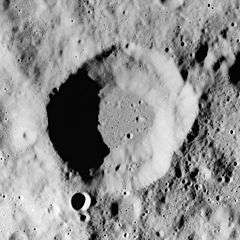Stein (lunar crater)
Stein is an elongated impact crater formation that lies just to the east of the larger crater Tiselius, on the far side of the Moon. Farther to the east-southeast of Stein lies Krasovskiy.
 Apollo 16 image | |
| Coordinates | 7.2°N 179.0°E |
|---|---|
| Diameter | 33 km |
| Depth | Unknown |
| Colongitude | 179° at sunrise |
| Eponym | Johan W. J. A. Stein |
This crater has an asymmetrical shape with an outward bulge along the north-northeastern rim. The resulting crater is roughly egg-shaped, with a wide ledge along the north-northwestern floor. The remaining crater is a bowl-shaped feature with simple slopes along the inner walls and a nearly featureless interior floor. The outer rim has not been significantly eroded, and is marked only by a tiny craterlet along the southern edge. There are small craterlets along the base of the inner wall along the north-northwestern side.
Satellite craters
By convention these features are identified on lunar maps by placing the letter on the side of the crater midpoint that is closest to Stein.
| Stein | Latitude | Longitude | Diameter |
|---|---|---|---|
| C | 8.9° N | 178.8° W | 27 km |
| K | 5.2° N | 180.0° W | 20 km |
| L | 4.6° N | 179.8° W | 15 km |
| M | 3.8° N | 178.8° E | 28 km |
| N | 2.2° N | 178.5° E | 16 km |
References
- Andersson, L. E.; Whitaker, E. A. (1982). NASA Catalogue of Lunar Nomenclature. NASA RP-1097.CS1 maint: ref=harv (link)
- Blue, Jennifer (July 25, 2007). "Gazetteer of Planetary Nomenclature". USGS. Retrieved 2007-08-05.CS1 maint: ref=harv (link)
- Bussey, B.; Spudis, P. (2004). The Clementine Atlas of the Moon. New York: Cambridge University Press. ISBN 978-0-521-81528-4.CS1 maint: ref=harv (link)
- Cocks, Elijah E.; Cocks, Josiah C. (1995). Who's Who on the Moon: A Biographical Dictionary of Lunar Nomenclature. Tudor Publishers. ISBN 978-0-936389-27-1.CS1 maint: ref=harv (link)
- McDowell, Jonathan (July 15, 2007). "Lunar Nomenclature". Jonathan's Space Report. Retrieved 2007-10-24.CS1 maint: ref=harv (link)
- Menzel, D. H.; Minnaert, M.; Levin, B.; Dollfus, A.; Bell, B. (1971). "Report on Lunar Nomenclature by the Working Group of Commission 17 of the IAU". Space Science Reviews. 12 (2): 136–186. Bibcode:1971SSRv...12..136M. doi:10.1007/BF00171763.CS1 maint: ref=harv (link)
- Moore, Patrick (2001). On the Moon. Sterling Publishing Co. ISBN 978-0-304-35469-6.CS1 maint: ref=harv (link)
- Price, Fred W. (1988). The Moon Observer's Handbook. Cambridge University Press. ISBN 978-0-521-33500-3.CS1 maint: ref=harv (link)
- Rükl, Antonín (1990). Atlas of the Moon. Kalmbach Books. ISBN 978-0-913135-17-4.CS1 maint: ref=harv (link)
- Webb, Rev. T. W. (1962). Celestial Objects for Common Telescopes (6th revised ed.). Dover. ISBN 978-0-486-20917-3.CS1 maint: ref=harv (link)
- Whitaker, Ewen A. (1999). Mapping and Naming the Moon. Cambridge University Press. ISBN 978-0-521-62248-6.CS1 maint: ref=harv (link)
- Wlasuk, Peter T. (2000). Observing the Moon. Springer. ISBN 978-1-85233-193-1.CS1 maint: ref=harv (link)